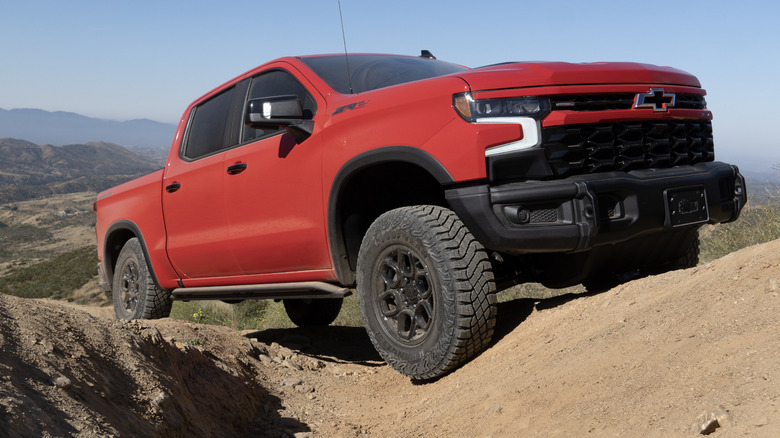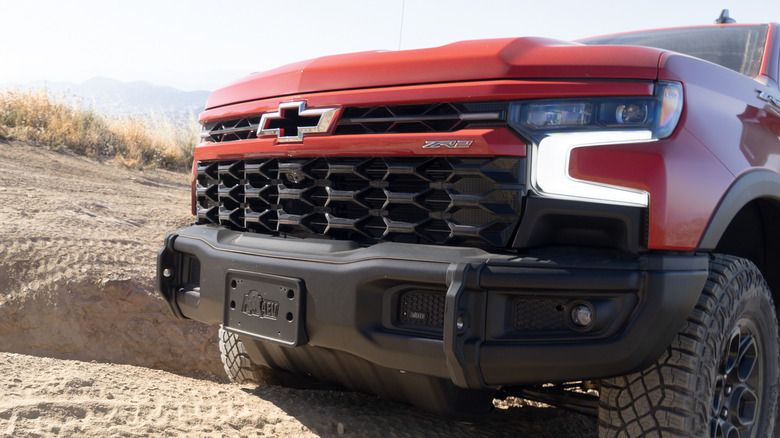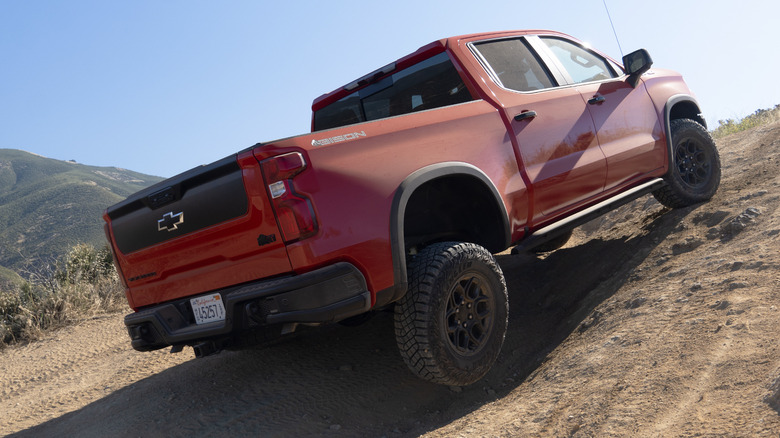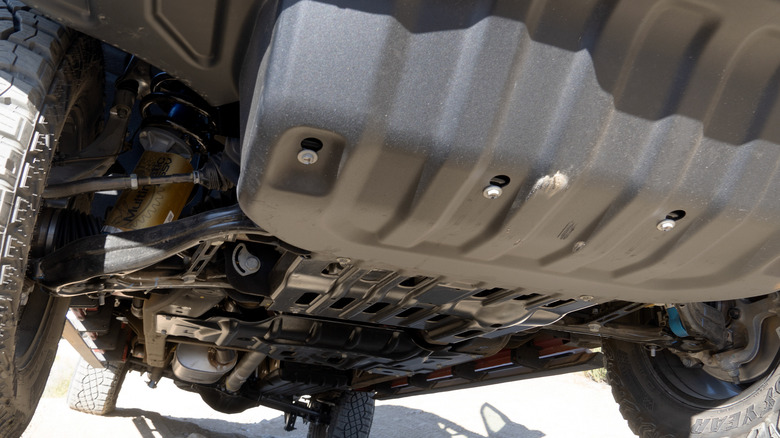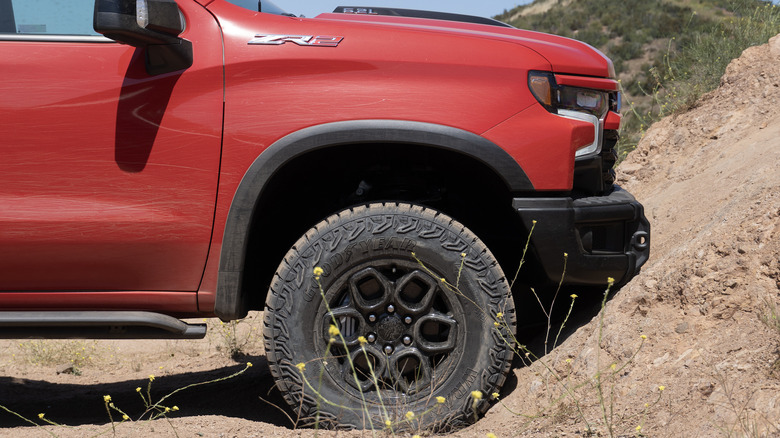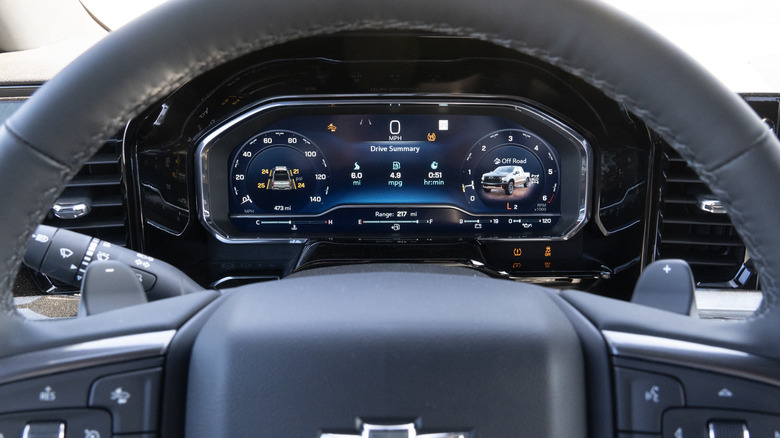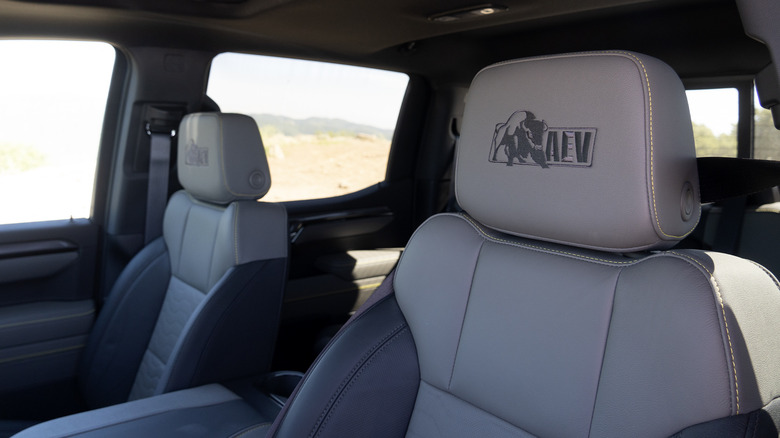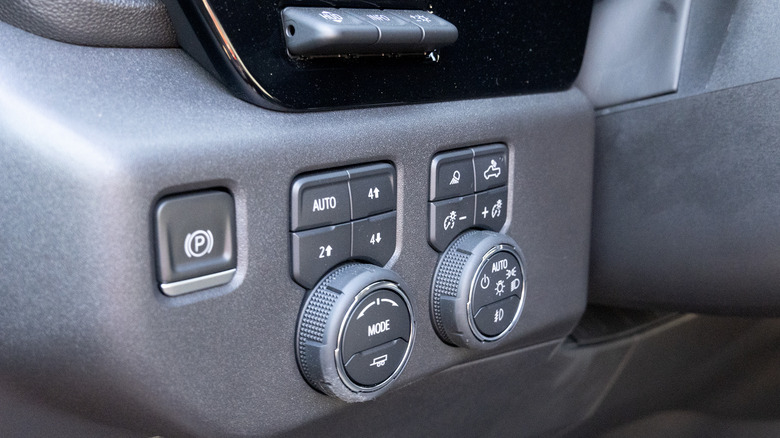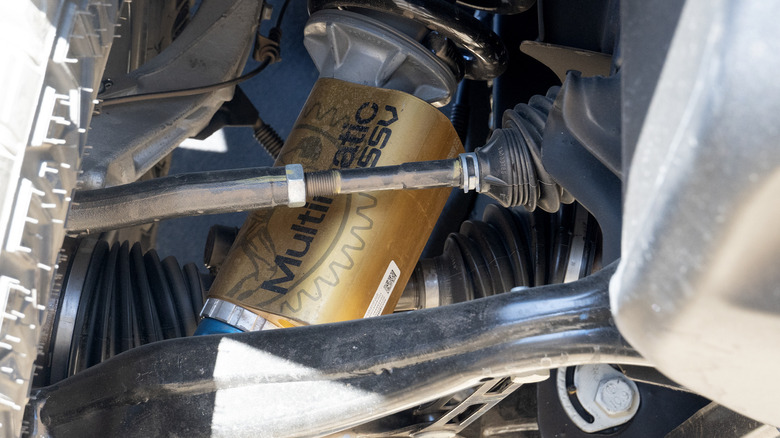2023 Chevrolet Silverado ZR2 Bison First Drive: Always Use Protection
A series of atmospheric river storms this past winter wreaked havoc on, and forced the closure of, many off-roading trails around California. So much so that at Rowher Flats, a popular OHV area just outside Los Angeles, the entry gate remained closed sporadically for months at a time even as four-wheeling season rapidly approached. And now with the dry months well underway, I barely recognize my favorite testing route for trucks and SUVs, awash with ruts and boulders torn up alternately by stormwaters and off-roaders tearing around scrabbling for grip.
Even from the cockpit of a brand-new Chevrolet Silverado ZR2 Bison, a series of new obstacles on the toughest 4x4 climb seem almost too big to overcome. Luckily, the Bison is a beefed-up version of Chevy's Silverado, with a bevy of protective gear bolted on by American Expedition Vehicles—aka AEV—in addition to the naturally aspirated V8, Multimatic dampers, and locking front and rear differentials that make the "base" ZR2 such an attractive package.
Chevrolet and AEV previously teamed up on the second-gen Colorado's Bison package, and by doing so for the first time on a Silverado, the duo clearly aims to provide an alternative for potential Ford F-150 Raptor or Ram Rebel and Power Wagon buyers. But when my early press loaner arrived with the same 33-inch tires as a "base" ZR2 and no additional lift—unlike past and forthcoming Colorado Bisons—my surprise nearly matched the sense of anticipation I later felt looking over the terrain at Rowher Flats, where the truck might need everything Chevy and AEV could have thrown at it.
Running a Bison in the desert
Of course, driving out to Rowher Flats, everything this new Bison shares with the ZR2 shone on highway and canyon roads alike. Namely, a peppy 6.2-liter V8 sending 420 horsepower and 460 lb-ft of torque to the rear or all four wheels through a 10-speed automatic transmission. Plus the Multimatic Dynamic Suspensions Spool Valve shocks, which somehow help a leaf-sprung truck feel almost as smooth as coil spring and five-link pickups. Inside, Chevy's simple design perfectly complements the spacious cabin made possible by a long wheelbase and short bed combination.
AEV's steel front and rear bumpers, rock sliders, and a grand total of five hot-stamped boron steel skid plates for the engine, transmission, transfer case, rear diff, and fuel tank only add more confidence to the ZR2 platform—confidence which I needed in spades precisely because of the Silverado's relatively long wheelbase and comparatively small (in this aggressive off-roading era, at least) 33-inch tires.
Gaining confidence higher up the mountain
I steadily chose more difficult lines the further I pushed the truck higher up the long climb at Rowher's eastern border, dipping tires into deeper and deeper elephant tracks without the Multimatics bottoming out or tires spinning for traction but finding only air. Airing down to a judicious 22-24 PSI always helps to keep wheelspin to a minimum, but unlike on the Colorado ZR2, the Silverado gets paddle shifters to better control that 10-speed's propensity to shift perhaps too often.
Instead, popping the gear selector into Low and the transfer case into 4-Low allowed me to essentially lock the truck in the lowest two gears and slowly trundle up and over rocky shelves and through cavernous ruts. Even when a wheel (or two) lifted off the dirt, the rear locker (selectable via a piano key on the dash) helped me maintain critical upward momentum—all the more important given the new curb weight of approximately 5,900 pounds with the additional AEV steel components.
Tougher where it matters
A disconnecting sway bar might help the Bison keep all four tires planted better, as on the Jeep Gladiator Rubicon or Ford Bronco. Regardless of packaging, though, the time always comes when I thank higher powers for skid plates and rock sliders—at Rowher Flats, about halfway up the hill I felt and heard a light scrape on the right slider first. Then the left knocked after a particularly tumultuous moment when I tried to engage the front locker, but it disengaged automatically (possibly because I toggled too far on the drive mode dial located to the left of the steering wheel, about as far as possible from the locking diff piano keys).
Next, I performed a scientific experiment on a lower skid plate by lifting my left front tire about a foot off the ground—entirely on purpose, assuredly—and hoping not to lift off throttle, powered up and over a sharper mini-ridge. That test of the Bison's ground clearance and breakover angle, logically rated at the same 11.2 inches and 23.4 degrees as the ZR2, proved equally as uneventful. The Bison just lumbered right on up the trail.
Improved, if not impressive, approach and departure angles
Trundling, lumbering, and trudging all imply a bit of heft. And throughout the day, even while hauling downhill again on a higher-speed section, the Bison's additional poundage (around 350 pounds more than the Silverado ZR2 that I put over 1,100 miles on in 10 days earlier this year) always stayed at the forefront of my mind. That's the cost of more protection underneath and better approach and departure angles, now slightly improved to 32.5 degrees and 23.4 degrees, respectively—not to mention looks.
Nicks or scrapes on skids and sliders are one thing, but I didn't want to risk tearing up those sparkling AEV front and rear bumpers on some final bouldering fun to wrap up the day. Even approaching the steepest obstacle, which a Hummer EV and Toyota Tacoma TRD Pro managed with only a few moments of concern, I knew that discretion was the better part of valor. Oh well, time to air up and head home.
Bison squares up to Raptor and Ram
Clearly, Chevy never intended any of the Silverado's trim levels—even Bison—for the kind of off-roading I subjected this poor brand-new loaner truck to at Rowher Flats. Rather, the ZR2 and Bison get just enough of the goodies to make quick work of short sections where a bit of extra care might prove wise, while excelling instead at higher-speed fun on dirt roads thanks to the damping of the Multimatics.
Want to tow? The ZR2's grunting V8 and leaf springs can handle that job. Want to roar around the ranch in smooth comfort, ventilated seats and music blasting? Silverado, no problem. Real rock crawling? Maybe a Bison, but maybe hedge that bet with some bigger tires and a lift to go along with the AEV upgrades.
Where Ford built the Raptor for hard-charging dune-running and Ram doubled down on the insanity with the supercharged Hemi-powered TRX, Chevrolet ticked down the list and saw that nobody offered quite the perfect combo of a naturally aspirated V8, leaf springs, towing capacity, and both front and rear lockers. At around the same price as a ZR2, a poverty-spec Raptor "only" gets a 450-horsepower twin-turbo V6. A Ram Power Wagon actually slots more properly against the 2500-series HD ZR2. And a Toyota Tundra with the I-Force Max hybrid seemingly bets big on efficiency, rather than all-out capability.
A closer look at AEV's add-ons
Those AEV add-ons do tally up quickly, though. On my truck, the whole package runs $7,895 and contributes to a ballooning window sticker over $85,000. That's a good bit higher than a "base" ZR2 at $67,000. What does the money buy? Well, those steel bumpers include heavy-duty recovery points and integrated step pads, plus the ability to easily install a front winch. A set of 18-inch wheels shod in Goodyear Wrangler Territory mud-terrains round off the cosmetics along with the rock sliders.
The "hot-stamped boron steel," meanwhile, allows Chevy and AEV to claim that the three-millimeter thick skids are three and a half times stronger than traditional cold-stamped high-strength steel. Up close and personal, all the AEV pieces look and feel substantial. My off-road excursions and ill-conceived YouTuber lines appeared to cause little more than surface scratches—given the sounds I heard over some Elvis inside the cabin, I'd say not bad. And don't forget the AEV-branded all-weather floor liners and headrests in there, too!
A quandary for Silverado ZR2 buyers
Many Chevy fans may well lament that the Silverado Bison lacks much of the fun factor that makes the recently revealed Colorado Bison so attractive. Blame fuel economy averages for the V8 engine and the brick-like aerodynamics of the Silverado's massive boxy nose, but bigger tires and more ground clearance would simply crush MPGs too much. Of course, a diesel might offset such concerns—hey, we can dream, right?
But therein lies the Silverado ZR2 Bison quandary. The unique attributes of a V8, Multimatic DSSVs and leaf springs, front and rear lockers, plus everyday comfort and versatility that Chevy combined at such a competitive price point on the ZR2 all make that truck unique in a flooded market. And yes, additional armor from AEV to protect that investment sounds (and looks) pretty good. But starting to tack on expensive goodies without a serious step up in capability quickly escalates into the arena of more hardcore trucks with more style, more substance, and, again, more sticker shock.
Spoiled for off-road pickup truck choice
Spoiled off-road pickup truck buyers these days happily enjoy the choice between Ford's Raptor and Raptor R, Ram's Rebel and Power Wagon, various TRD trims from Toyota, or even a Nissan Titan Pro-4X. Amid the scrum, Chevy can no doubt bank on plenty of brand loyalty from dyed-in-the-wool Silverado fans. Whether or not half-ton Silverado Bison owners then want to buy a set of 35s to the tune of $1,500 (and up) or a lift kit that might compromise the sublime performance of their Multimatics stands out as a worthwhile question.
Or maybe just wait to buy a Colorado Bison for more regular rock crawling duties, and pick the Silverado Bison when only an occasional day in the ruts and washes of post-apocalyptic weather fits into the plan. I can attest the Silverado ZR2 Bison will get the job done, and without a lift or tires providing more ground clearance, all that AEV armor will certainly prove its worth in the meantime.
